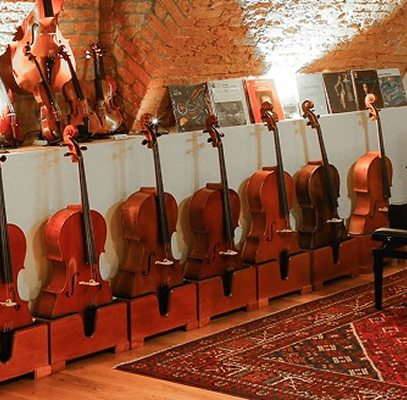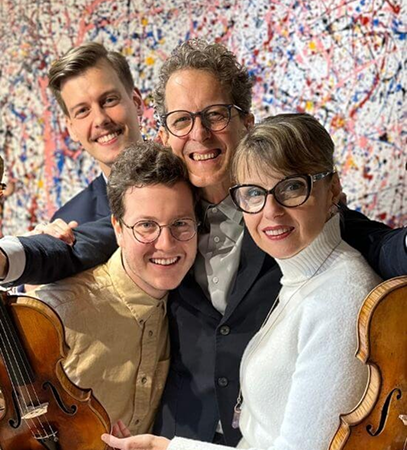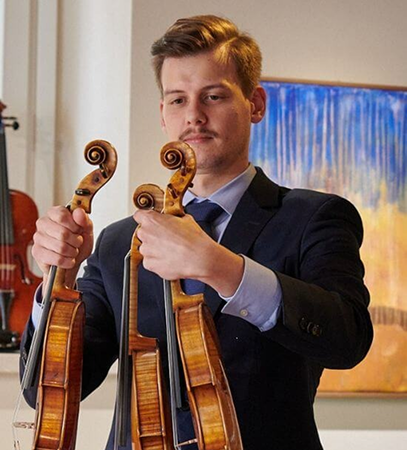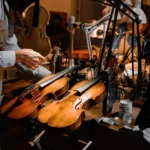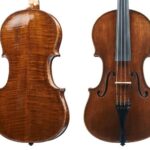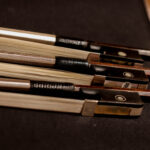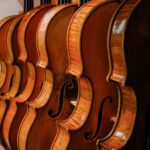Why Fine Violins Appreciate Over Time: The Investment Side of Art
Back to BlogFine violins are more than instruments: they’re enduring works of art that appreciate in value over time. From Cremona’s legendary craftsmanship to the modern collector’s market, discover how factors like maker, condition, and provenance shape the investment potential of fine violins for sale.
When art meets sound, the result is not only beauty but also value. Fine violins have long been considered treasures of craftsmanship, and in recent years, they’ve proven to be solid assets in the investment world.
For example in 2025, a 1714 Joachim-Ma Stradivari violin fetched $11.25 million at auction, according to The Strad. This record-breaking sale highlights how rare string instruments can transcend time and trends, offering both cultural and financial appreciation.
The market of fine violins around the world
The market for fine violins is a unique segment of the art investment landscape. It’s driven primarily by private collectors, musicians, and specialized dealers rather than large public markets.
European centers like London, Paris, and Cremona, along with the United States and Japan, are key players in this trade. Demand is steady, often fueled by the limited number of historical instruments and the continuous recognition of their tonal and artistic excellence.
Unlike traditional financial assets, fine violins offer intrinsic value through craftsmanship and sound quality. Their rarity and historical significance mean that demand often outpaces supply, especially for instruments made by master luthiers such as Stradivari, Guarneri del Gesù, and Amati.
Is buying a violin a good investment?
Buying a fine violin can be a rewarding investment, both emotionally and financially. While these instruments are not as liquid as stocks or real estate, they tend to appreciate steadily over time. Returns are often realized after several years or decades, making violins suitable for patient collectors who appreciate their dual nature as both art and asset.
Fine violins also tend to hold their value even in uncertain markets. Unlike many speculative investments, they are tangible, historical, and backed by centuries of musical tradition. For investors who understand the market, purchasing one of these instruments is not just a financial decision but also a way of preserving cultural heritage.
Important factors that impact auctions in a fine violin
The auction performance of a fine violin is rarely determined by a single element. Instead, it’s the result of a delicate balance between craftsmanship, preservation, history, and market timing.
Each instrument tells its own story (from the hands that built it to the musicians who played it) and these details can dramatically affect its value under the hammer. Collectors and investors who understand these nuances are better equipped to recognize opportunity, evaluate authenticity, and make informed decisions when participating in highend sales.
Maker and Age
The maker and age of a violin are among the most influential factors in its valuation. Instruments crafted by renowned luthiers such as Stradivari or Guarneri del Gesù command exceptional prices due to their craftsmanship, history, and rarity.
Modern violins made by highly regarded contemporary makers can also gain significant value when properly cared for.
That is why understanding the subtle distinctions between genuinely old instruments from copies is essential for investors and musicians alike.
Instrument condition
The physical condition of a violin is one of the most decisive elements in its valuation. A well-preserved instrument is not only aesthetically appealing but also capable of maintaining its original acoustic character.
Signs of good condition include a stable structure with no open seams, minimal cracking, and varnish that retains its natural patina rather than showing signs of heavy restoration or over-polishing. Regular maintenance and proper storage ensure the violin’s longevity, preserving both its beauty and its ability to inspire musicians for generations to come.
Provenance and Location
An instrument’s provenance can dramatically influence its market value. Collectors and musicians often view a violin’s story as an extension of its soul. Instruments with well-documented lineages, especially those once owned or played by renowned musicians, can achieve exceptional prices.
Nowhere is this more evident than in Cremona, Italy, the birthplace of the world’s most celebrated violin makers such as Antonio Stradivari, Guarneri del Gesù, and Amati. A violin that can trace its craftsmanship back to Cremona’s golden age carries not only historical prestige but also a guarantee of exceptional tonal quality and artistry.
Provenance from this region acts almost like a hallmark of authenticity, elevating both the instrument’s desirability and its market potential.
For collectors considering resale, maintaining detailed documentation is essential. These records don’t just confirm legitimacy; they preserve the instrument’s legacy and reinforce buyer confidence, ensuring that its story continues to resonate across generations.
Market trends
Market trends for fine violins fluctuate depending on global demand, cultural interest, and economic conditions. While auctions provide public benchmarks, they often represent only 60% to 70% of the instrument’s actual market value.
Private sales, conducted discreetly through dealers and collectors, tend to achieve higher and more consistent returns.
What to consider before putting a fine violin for sale
Successfully selling a fine violin requires careful planning and a deep understanding of the market. The resale process is highly specialized, with private negotiations often determining the final price.
Several key factors can influence the outcome, and attention to detail can significantly enhance both the financial and cultural value of the instrument.
When preparing to sell, consider the following:
- Timing of the Sale: Market demand fluctuates, and the optimal moment to sell can vary depending on trends, collector interest, and auction cycles. Strategic timing can maximize returns.
- Condition of the Instrument: Violins that are well-maintained, with minimal restorations and original varnish preserved, are more likely to attract serious buyers and achieve higher prices.
- Provenance and Documentation: Detailed records of ownership, certificates of authenticity, and historical provenance enhance credibility and reassure potential buyers.
- Market References: Familiarity with auction results and private sale data helps set realistic expectations for pricing and sale strategy.
- Cultural and Emotional Value: Beyond financial considerations, the instrument’s historical significance and artistic appeal can influence buyer interest and perceived value.
Understanding these factors ensures that your fine violin is positioned for a successful sale, preserving both its legacy and investment potential.
Meet Our Luthiers and Explore Fine Violins for Sale
At Amorim Fine Violins, every instrument is treated as a living work of art. Our expert luthiers specialize in restoration, maintenance, and acquisition of rare violins that meet the highest artistic and investment standards. Whether you are expanding your collection or looking for fine violins for sale, our specialists can guide you through every step, ensuring transparency and authenticity.
Discover our exclusive collection of rare instruments and experience the sound, history, and investment value that only a fine violin can offer.

